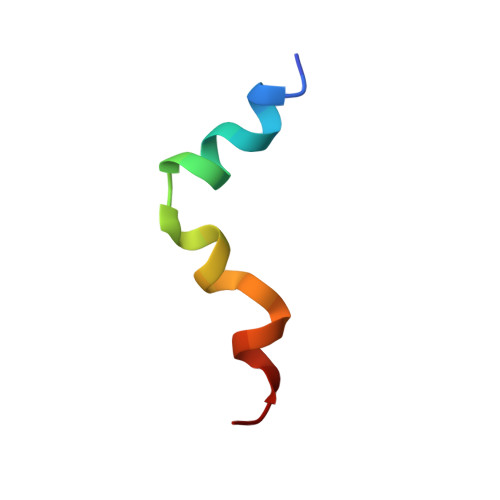Specific motifs of the V-ATPase a2-subunit isoform interact with catalytic and regulatory domains of ARNO
Merkulova, M., Bakulina, A., Thaker, Y.R., Gruber, G., Marshansky, V.(2010) Biochim Biophys Acta
- PubMed: 20153292
- DOI: https://doi.org/10.1016/j.bbabio.2010.02.009
- Primary Citation of Related Structures:
2KPA, 2KPB - PubMed Abstract:
We have previously shown that the V-ATPase a2-subunit isoform interacts specifically, and in an intra-endosomal acidification-dependent manner, with the Arf-GEF ARNO. In the present study, we examined the molecular mechanism of this interaction using synthetic peptides and purified recombinant proteins in protein-association assays. In these experiments, we revealed the involvement of multiple sites on the N-terminus of the V-ATPase a2-subunit (a2N) in the association with ARNO. While six a2N-derived peptides interact with wild-type ARNO, only two of them (named a2N-01 and a2N-03) bind to its catalytic Sec7-domain. However, of these, only the a2N-01 peptide (MGSLFRSESMCLAQLFL) showed specificity towards the Sec7-domain compared to other domains of the ARNO protein. Surface plasmon resonance kinetic analysis revealed a very strong binding affinity between this a2N-01 peptide and the Sec7-domain of ARNO, with dissociation constant KD=3.44x10(-7) M, similar to the KD=3.13x10(-7) M binding affinity between wild-type a2N and the full-length ARNO protein. In further pull-down experiments, we also revealed the involvement of multiple sites on ARNO itself in the association with a2N. However, while its catalytic Sec7-domain has the strongest interaction, the PH-, and PB-domains show much weaker binding to a2N. Interestingly, an interaction of the a2N to a peptide corresponding to ARNO's PB-domain was abolished by phosphorylation of ARNO residue Ser392. The 3D-structures of the non-phosphorylated and phosphorylated peptides were resolved by NMR spectroscopy, and we have identified rearrangements resulting from Ser392 phosphorylation. Homology modeling suggests that these alterations may modulate the access of the a2N to its interaction pocket on ARNO that is formed by the Sec7 and PB-domains. Overall, our data indicate that the interaction between the a2-subunit of V-ATPase and ARNO is a complex process involving various binding sites on both proteins. Importantly, the binding affinity between the a2-subunit and ARNO is in the same range as those previously reported for the intramolecular association of subunits within V-ATPase complex itself, indicating an important cell biological role for the interaction between the V-ATPase and small GTPase regulatory proteins.
Organizational Affiliation:
Center for Systems Biology, Program in Membrane Biology and Division of Nephrology, Department of Medicine, Massachusetts General Hospital and Harvard Medical School, Boston, MA 02114, USA.














